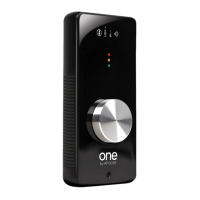Apogee ONE | User’s Guide for Windows
Figure
B.
By routing the hardware input directly to the hardware output and mixing in playback as shown in
Figure B , it’s possible to provide the vocalist a headphone monitoring signal with a much shorter
delay. First, the signal being recorded (in this case, a vocal mic) is split just after the A/D stage and
routed to both the software application for recording and directly back to the hardware outputs without
going through the latency-inducing software. This creates a low latency path from mic to headphones.
Next, a stereo mix of playback tracks is routed to the low latency mixer and combined with the
hardware input(s). This allows the performer to hear himself while listening to playback tracks without
a confusing delay in order to comfortably record overdubs.
Note that the software application’s mixer is used to set a stereo mix of playback tracks while the low
latency mixer is used to set the balance between the stereo playback mix and the hardware inputs.
Page 27

